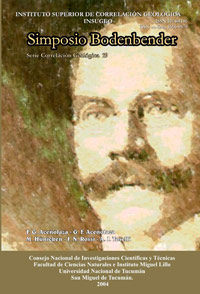Serie Correlación Geológica 19
El Plutón San Blas, Magmatismo Posdeformacional Carbonífero en la Sierra de Velasco
Miguel A. Báez | Miguel A. Basei
Descargar trabajo en formato PDFResumen
EL PLUTÓN SAN BLAS, MAGMATISMO POSDEFORMACIONAL CARBONÍFERO EN LA SIERRA DE VELASCO. La Sierra de Velasco esta integrada por un conjunto de cuerpos plutónicos, de diferentes niveles intrusivos, formas y edades. En el sector norte se destacan monzogranitos y sienogranitos porfiroides no deformados del plutón San Blas. Este muestra claras relaciones intrusivas por el oeste, con el ortogneis Antinaco, por el este con el plutón Asha, no deformado. Este último a su vez intruye en el pórfido tonalítico subvolcánico de la Punta Negra. Las relaciones de campo entre el plutón San Blas y sus rocas de caja son claras con respecto a sus edades relativas. En dataciones U-Pb de monacitas y circones en los granitos San Blas y Asha se han obtenido 334 Ma para el primero y 343 Ma para el segundo, confirmando así los datos de campo.
Abstract
THE SAN BLAS PLUTON, CARBONIFEROUS POSTDEFORMATIONAL MAGMATISM IN THE SIERRA DE VELASCO. The Sierra de Velasco is conformed by various plutonic bodies with different intrusive levels, shapes and ages. The northern sector is occupied by undeformed porphyritic monzo and syenogranites of the San Blás pluton. It shows clear intrusive relationships with the Antinaco Orthogneis towards the west and with the undeformed Asha pluton towards the east. The Asha pluton in turn intrudes the Punta Negra subvolcanic tonalitic porphyry. Field relationships between the San Blás pluton and its host rocks are clear with respect to their relative ages. U-Pb dating on monazites and zircons of the San Blás and Asha granites have given 334 Ma and 343 Ma respectively, thus confirming the field data.






